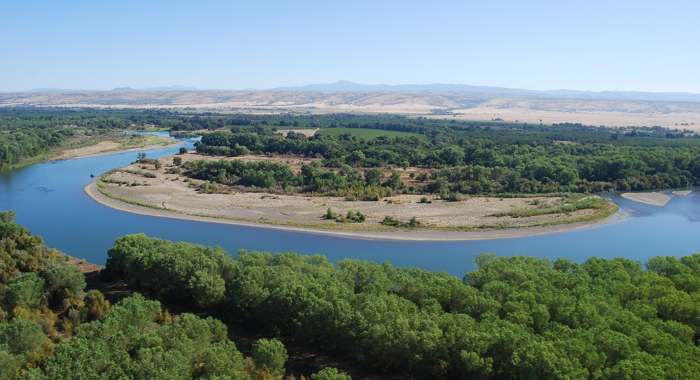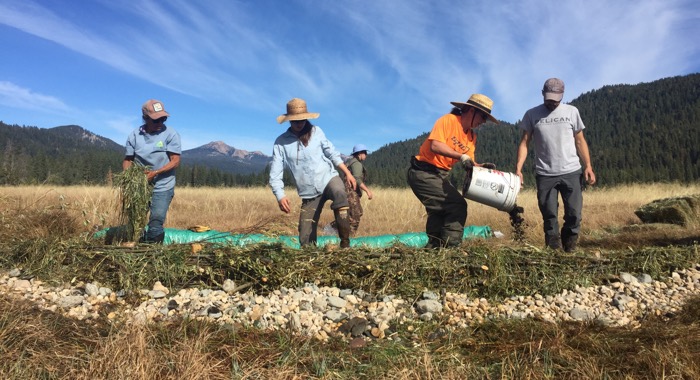Californians have fundamentally altered many of the state’s rivers and streams with dams, pipes, and diversions, and the State is home to some of the world’s most complex water delivery projects. As an unfortunate consequence, habitat for many freshwater species has been degraded or destroyed.
But, is it necessary to tradeoff the freshwater needs of birds, fish, and other species against the needs of farms and cities? Could freshwater flows be managed to better mimic the dynamics of their unimpaired past, dynamics to which native species have adapted and need to persist? And how should climate change considerations be incorporated into water management, to enhance the resilience of freshwater systems for both people and nature?
Our science is focused on tackling these questions.


Jeanette K. Howard, Kirk R. Klausmeyer, Kurt A. Fesenmyer, Joseph Furnish, Thomas Gardali, Ted Grantham, Jacob V. E. Katz, Sarah Kupferberg, Patrick McIntyre, Peter B. Moyle, Peter R. Ode, Ryan Peek, Rebecca M. Quiñones, Andrew C. Rehn, Nick Santos, Steve Schoenig, Larry Serpa, Jackson D. Shedd, Joe Slusark, Joshua H. Viers, Amber Wright, Scott A. Morrison
The California Freshwater Species Database is the first comprehensive geospatial database of California’s freshwater species compiled and standardized into single format from nearly 500 sources.…Walter N. Heady, Kevin O'Connor, Jennifer Kassakian , Kate Doiron, Charles Endris, Daniel Hudgens, Ross P. Clark , Jena Carter , Mary G. Gleason
Estuaries are some of the most productive ecosystems on the planet. This inventory classifies more than 600 coastal confluences on the West Coast of the United States. Each estuary was classified…Jennifer K. Carah, Christopher C. Blencowe, David W. Wright
Coho salmon in California are critically imperiled so there is strong impetus to achieve as much habitat restoration as possible in priority watersheds quickly and with limited resources. This paper…Eric Hallstein, Matt Miller
Golet G.H., D.L. Brown, M. Carlson, T. Gardali, A. Henderson, K.D. Holl, C.A. Howell, M. Holyoak, J. Hunt, G.M. Kondolf, E.W. Larsen, R.A. Luster, C. McClain, C. Nelson, S. Paine, W. Rainey, Z. Rubin, F. Shilling, J.G. Silveira, H. Swagerty, N.M. Williams, D.M. Wood
Large-scale ecosystem restoration projects seldom undergo comprehensive evaluation to determine project effectiveness. Consequently, there are missed opportunities for learning and strategy…Jeanette Howard, Kirk Klausmeyer, Kurt Fesenmyer
Californians face profound decisions regarding the management of their state’s increasingly limited water supply. Critical for decision-making is information about the plants and animals that…Golet G.H., J. Hunt, D. Koenig
Floodplains often are managed both for agriculture and as habitat for native species. On the Sacramento River, farmers have expressed concern that natural areas may be sources of pests to adjoining…Jennifer Carah, Jason Pelletier
A two-page summary of salmon restoration efforts at the Garcia River Forest on the North Cost of California focusing on the reintroduction of wood in streams as a strategy.The Nature Conservancy, Jennifer Carah
Salmon and trout thrive in streams with cool water, low levels of sand and silt, and deep, shaded pools. Intensive forest management in California over the last 150 years led to the removal of these…Stralberg, D., D. Cameron, M. Reynolds, C. Hickey, K. Klausmeyer, S. Busby, L. Stenzel, W. Shuford, G. Page
This analysis provides the first comprehensive overview of the specific habitats used by 42 different migratory waterbird species throughout California. The authors reveal important gaps in…Golet G.H., T. Gardali, C. Howell, J. Hunt, R. Luster, B. Rainey, M. Roberts, H. Swagerty, N. Williams
Studies that assess the success of riparian restoration projects seldom focus on wildlife. More often, vegetation is studied, with the assumption that animal populations will recover once adequate…Gardali T. , A.L. Holmes, S.L. Small, N. Nur, G.R. Geupel, G.H. Golet
Restoration efforts on the Sacramento River are focusing on revegetating the land with native plants and restoring natural river processes in an attempt to recover wildlife populations. To evaluate…Golet G.H., M.D. Roberts , E.W. Larsen, R.A. Luster, R. Unger, G. Werner, G.G. White.
River restoration projects have the potential to influence many of the services that rivers provide to people, yet rarely is this studied in a comprehensive manner. This paper reports on a set of…